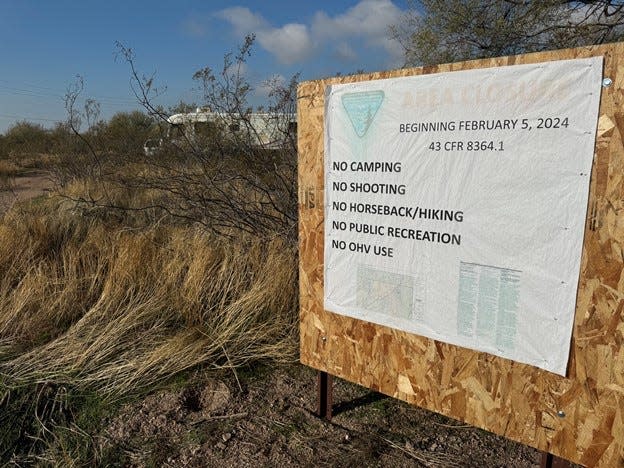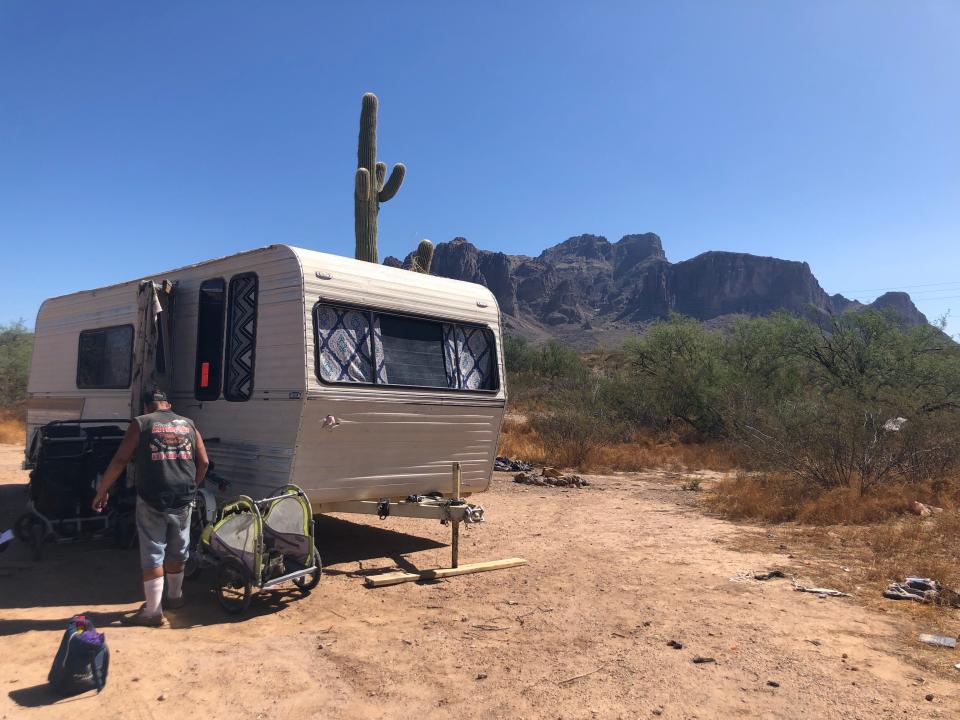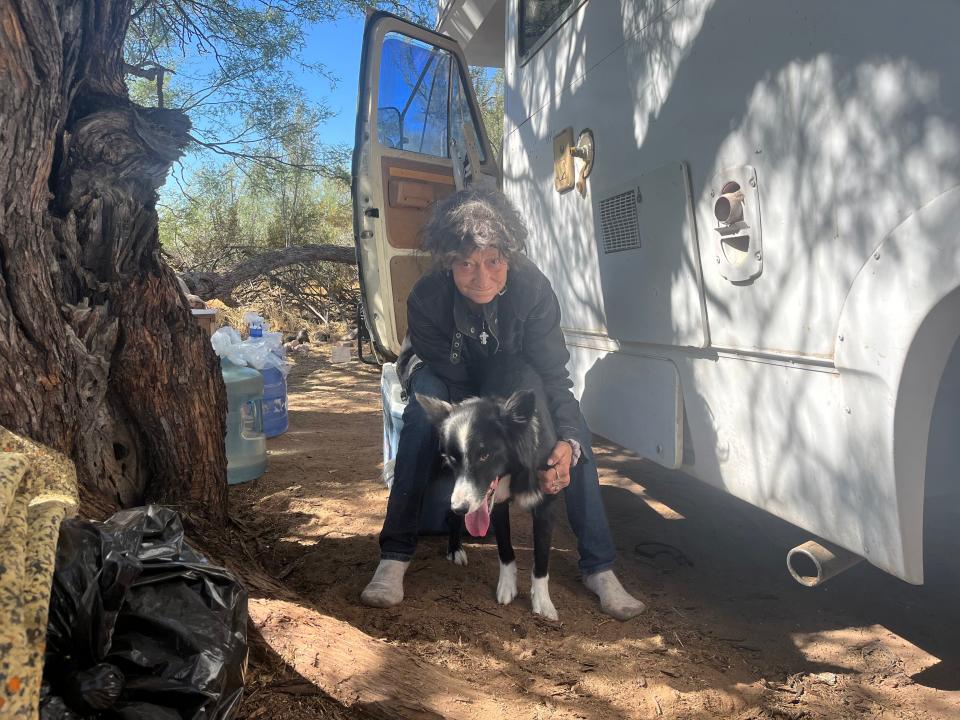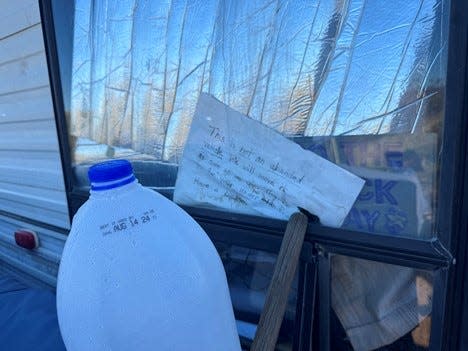Homeless campers were forced to leave BLM land in Pinal County. Where did they go?
As Monday morning dawned, Joan Terrall was in a hurry.
The 67-year-old darted back and forth between her tent and a friend’s camper as she prepared to leave the patch of desert land that she’d called home for the past two years.
The area outside Goldfield Ghost Town, an 1800s-themed tourist attraction up the road from Apache Junction in Pinal County, had long served as a landing spot for those in need of a place to stay. Terrall and her boyfriend were among a few dozen people living in tents, cars and campers scattered across the informal community.
But now, she had to leave. The land’s owner, the Bureau of Land Management, plans to convert it into a 1,100-acre recreation area. They wanted everybody out by 12:01 a.m. on Monday — meaning Terrall and many of her neighbors were already overstaying their welcome as they packed.
BLM’s decision came after years of local concerns about trash, illegal camping, and fire risks in the area, as well as increasing pressure for park spaces near fast-growing metro Phoenix.

Some worried driving out the people who already lived in the area could push them further into rural desert areas, putting them at increased risk of crime, dehydration and other dangers.
It's a dilemma similar to those playing out in urban areas, as government officials weigh public safety and possible neighborhood nuisances against displacing homeless people and moving them farther away from services.
The land offers superb views of the Superstition Mountains, less than an hour away from the densely packed heart of the state. Planned amenities such as trails for hiking, mountain biking and horseback riding will complement outdoor opportunities in nearby Tonto National Forest, Lost Dutchman State Park and Peralta Regional Park.
BLM officials posted signs in January informing Terrall and her neighbors of the deadline.
Terrall initially said she hoped to be out of the area on time. She spent days trying to find a motel room where she and her boyfriend could stay.
She thought she’d found one in east Mesa until she discovered that she would have to pay $1,300 upfront to reserve the room for a week, even if it was later covered by assistance programs.
“You’re helping homeless people,” Terrall said. “I don’t have that kind of money.”
Ultimately, she changed her plans. A friend invited her to stay near her campsite on state trust land off Peralta Road, outside of Gold Canyon. Bret Dawkins, 58, another friend who also was leaving BLM land, offered to give Terrall and a few others a ride over.
As she prepared to leave, Terrall said staying at her friend’s campsite was only a temporary fix. Law enforcement are “strict” about the two-week camping limit in the Peralta Road area, she said.
It’s also far out in the desert with nothing around. That’s less than ideal for Terrall, who doesn’t have a car and will have to figure out how to get to the closest grocery store for supplies.
Still, she said it’s better than nothing.
“We’ll make it,” she said. “But it’s going to be tough.”

Packing up camp
Tony Tozier, 63, was packing his belongings on Monday not far from Terrall’s campsite.
In the days before the deadline, he’d managed to get his van running and his items mostly packed in bins scattered around his camping area.
But his work was far from done. He needed to transport his belongings and find a new place to stay. He promised to help his friends, Rose Sherwood, 69, and Bill Shelly, 58, get their possessions out of the area.
Plus, Tozier recently had a heart attack. He had a Monday afternoon appointment with his cardiologist to receive medication and check up on his recovery.
As he sorted through his items Monday morning, two BLM rangers pulled up to his campsite. They spoke with Tozier for about 20 minutes before handing him a violation notice.
Tozier said one of the rangers promised they’d rip up the notice and dismiss the violation if he left the area as soon as he could.
“He’s a good cop,” Tozier said of the BLM ranger. “He’s trying … if I get out of here, he won’t bother me.”
BLM rangers had made just one closure-related arrest as of Thursday, according to spokesperson Chris Wonderly. Several other people were arrested by the Pinal County Sheriff’s Office on outstanding warrants, he said.
Pinal County officials said animal shelter staff were on call to assist with any pets left behind by people leaving the area, but hadn’t received any as of Friday.
Wonderly said the majority of people living in the area left on Monday, but a handful remained as of Thursday. A “significant” amount of trash was left in the area and officials will create plans to remove it once every camper has left, he said.

Where did all the people go?
On Friday, most people who had left the Goldfield area said they remained somewhere in the desert.
Sherwood and Shelly ran into trouble with their camper. They had hoped the vehicle could make it to a plot of land they own near Kingman, about 250 miles away, but it broke down just a few minutes up the road from their former home.
Meanwhile, Tozier said he ran out of time to pack up most of his belongings. He ended up leaving behind most of his bins and nearly all of his blankets.
The ranger he encountered dismissed his violation, he said. But as the week went on, he said he observed law enforcement officials get pushier with the people left in the area.
“They treat you like you’re some criminal or something,” he said, saying he felt there were fewer places to go now.
Tozier, Sherwood and Shelly are now all camped out alongside the highway and facing mounting challenges.
Tozier said he has no source of heat in his car, where he normally sleeps. Without his blankets, he’s increasingly worried about the cold nights ahead. Temperatures near Apache Junction fell to 40 degrees by Thursday, with snow dusting the tops of the Superstition Mountains.
Sherwood and Shelly are living off a supply of instant ramen. They said they only have enough left for a few more days, and their camper still isn’t running.
They’re not sure when they’ll be able to make it to the grocery store or the Genesis Project, an Apache Junction soup kitchen that feeds many homeless individuals in the area.
Right now the group is taking it day by day, in hopes of getting the RV off the road and to a place where they can make repairs. They said they're waiting for law enforcement to come speak to them, but it hasn't happened yet.
"They just keep driving by, driving by, driving by," Shelly said.
Gina Barker, 51, told The Republic she was camping in her car and hopping between parking lots. She spent Thursday night in a lot near Sossaman Road and Southern Avenue in east Mesa, sick with pneumonia.
Terrall, the woman who said she was headed to the Peralta Road area, and Dorothy Bolen, a 62-year-old who said she didn’t know where she would go, didn’t return The Republic’s call on Friday.

In many rural places, a lack of shelter
None of the people The Republic spoke with on Friday were in a shelter or receiving housing services.
Before the clear-out, BLM officials said they would direct people living in the area to Arizona's 2-1-1 social services hotline and the Genesis Project, the Apache Junction soup kitchen.
But the agency wasn’t providing services directly, and Wonderly couldn’t tell The Republic on Thursday how many people had sought or received services before leaving their campsites.
The 2-1-1 hotline provides an online dashboard that shows who is calling in to request assistance. It shows 60 people called the hotline within the past 30 days from within the zip code that encompasses the Goldfield area. Of those, 40% of callers were seeking housing services such as emergency shelter, low-cost housing and mortgage assistance.
But housing services are scarce in the area. Pinal County does not have an emergency homeless shelter for the general public — and it’s not the only one. Apache, Greenlee, La Paz, Navajo and Yuma counties also lack community shelters, hotline officials said.
Local officials say that creating and operating a homeless shelter open to the public is a complicated endeavor. It requires funding, community buy-in and partnerships between governments and nonprofits.
Dashboard data shows the 2-1-1 hotline, which is run by the nonprofit Solari Crisis Response Network, has received nearly 600 calls so far this year related to housing services from all counties without community homeless shelters.
Calls from Pinal County make up the bulk of that number. Hotline officials have received more than 487 calls from Pinal County since the start of the year related to housing needs, per the dashboard.
Even if there were shelters, Solari President Andrew Erwin said they’d probably be full. The entire state is facing a housing crisis, he said, and a lack of affordable housing is the biggest barrier to getting people off the streets.
Erwin said nearby Maricopa County does have shelters — although not nearly enough to help all of the homeless individuals in the Phoenix metro area.
But many of the people living in the Goldfield area told The Republic they had not called the hotline to see if those shelters could help them. Terrall said she tried calling the hotline once years ago, but hadn’t found it helpful.
Erwin said it’s hard to say just how many people choose not to seek out help because they assume it is unavailable or that it means moving to a different area of the state.
“It’s one of those things where it’s trying to measure that thing that doesn’t happen,” Erwin said. “We’ve done a lot of work in rural and frontier Arizona, and I think there is a mentality of, ‘I need to figure this out on my own.’ I think that is just part of the culture. We try to do whatever we can to market out into those communities that we are a resource.”
Sasha Hupka covers county government and election administration for The Arizona Republic. Do you have a tip to share on elections or voting? Reach her at sasha.hupka@arizonarepublic.com. Follow her on X, formerly Twitter: @SashaHupka. Follow her on Threads: @sashahupkasnaps.
Helen Rummel covers higher education for The Arizona Republic. Reach her at Helen Rummel covers higher education for The Arizona Republic. Reach her at hrummel@azcentral.com. Follow her on X, formerly Twitter: @helenrummel.
This article originally appeared on Arizona Republic: Homeless campers were forced off BLM land. Where did they go?

